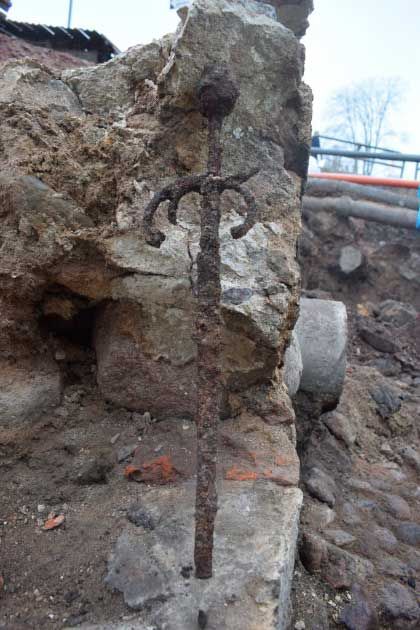Archaeologists in the historic city of Kalmar, Sweden, have uncovered a remarkable artifact that sheds new light on the evolution of military tactics and weaponry. A rare 17th-century battle-sword, buried beneath a 400-year-old cellar floor, offers an extraordinary glimpse into the military history of the early modern period. This discovery not only provides insight into the turbulent era of the Kalmar War but also underscores the broader transformation in European warfare.

The excavation, conducted by the highly respected Swedish archaeological firm Arkeologerna, took place at the intersection of Kungsgatan and Västerlånggatan. This location, once the site of a medieval farm, played a pivotal role during the Kalmar War of 1611-1613. As the team carefully sifted through layers of historical sediment, they encountered more than just an ancient weapon—they uncovered a tangible piece of the past that tells a compelling story of conflict, technological advancement, and societal change.
The Kalmar War was a defining conflict between Sweden and Denmark-Norway, fueled by territorial disputes and competition over crucial trade routes. Kalmar, a strategically important city, became a focal point of the war. The discovery of a Danish battle-sword beneath the ruins of a fire-ravaged structure serves as a stark reminder of the brutal battles that took place in the area. It is a testament to the intensity of the conflict and the ever-present struggle for dominance in the Baltic region during the early 17th century.
What makes this find particularly significant is its relevance to the “Military Revolution,” a period spanning from approximately 1560 to 1660, during which European warfare underwent profound changes. This transformation saw the decline of traditional medieval combat techniques and the rise of more sophisticated military strategies and weapon designs. The recovered sword represents a crucial evolutionary step in the development of arms, bridging the gap between the heavy, cumbersome swords of the medieval period and the refined, more agile weaponry that would come to define the 17th century.
During the Military Revolution, advances in metallurgy and engineering led to the production of lighter, more durable weapons that allowed for greater mobility and efficiency in combat. The design of this particular sword likely reflects the shift towards weapons that prioritized speed and precision over brute force. This evolution in weaponry mirrored broader changes in battlefield tactics, including the increased use of disciplined infantry formations, standardized firearms, and coordinated maneuvers that laid the foundation for modern military strategy.
The sword itself, found remarkably well-preserved despite centuries underground, provides invaluable insight into the craftsmanship of the time. Archaeologists are meticulously analyzing its composition, design, and possible origins to understand its role in the conflict. Was it wielded by a high-ranking officer, a skilled soldier, or a mercenary hired to fight in the war? Each detail—from the curvature of the blade to the composition of the metal—offers clues about the manufacturing techniques and combat styles employed during the period.
The presence of the sword in a fire-damaged building adds another layer of intrigue. The destruction of the structure suggests that it may have been a casualty of the war itself, perhaps burned during an attack or abandoned as troops moved through the city. The fact that the sword was left behind raises further questions—was it lost in battle, deliberately hidden, or simply forgotten in the chaos of war? Each possibility paints a vivid picture of the intense and often unpredictable nature of 17th-century warfare.
Beyond its immediate historical significance, this discovery has broader implications for our understanding of early modern military history. The Kalmar War was one of many conflicts that shaped the geopolitical landscape of northern Europe, influencing the balance of power between Sweden, Denmark-Norway, and other emerging states. By studying artifacts like this battle-sword, historians and archaeologists can piece together a more detailed and nuanced narrative of how warfare evolved during this transformative period.
Preserving such artifacts is crucial to deepening our understanding of the past. Each discovery adds to our collective knowledge and helps bridge the gap between historical scholarship and public awareness. The meticulous process of excavation, conservation, and analysis ensures that these relics remain accessible for future generations, allowing historians to continue uncovering new aspects of our shared heritage.
As researchers continue to study this sword, they are not merely examining an old weapon—they are unraveling a story that connects past and present. This artifact serves as a powerful reminder that history is not confined to books and archives; it exists beneath our feet, waiting to be rediscovered. The echoes of past conflicts, technological advancements, and cultural shifts still resonate today, offering valuable lessons about the forces that have shaped the modern world.
The battle-sword unearthed in Kalmar is more than a relic of Sweden’s military past; it is a tangible link to an era of profound change and innovation. It highlights the rapid evolution of warfare, the shifting nature of power struggles, and the resilience of those who lived through these turbulent times. As we continue to analyze and learn from such artifacts, we gain not only a deeper understanding of history but also a renewed appreciation for the complexities of human civilization.
This discovery reinforces the importance of archaeology in uncovering the stories that define our past. By carefully excavating and preserving these pieces of history, we ensure that they remain a vital part of our collective memory. The Kalmar sword, with its unique place in military history, offers an extraordinary glimpse into the past while reminding us that the legacies of history continue to shape our present and future.





